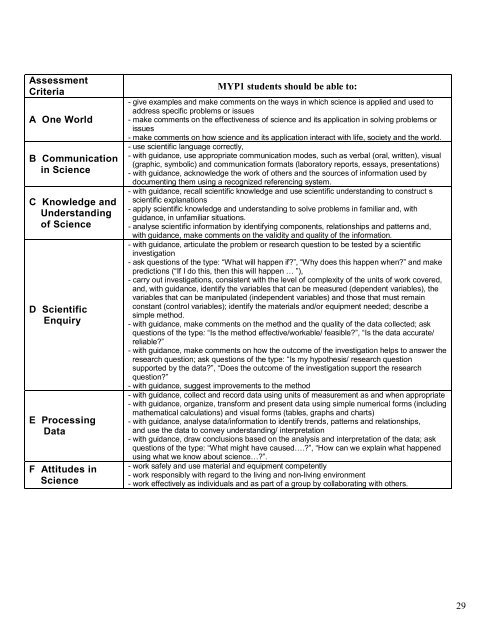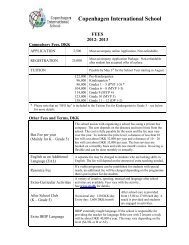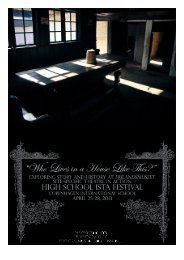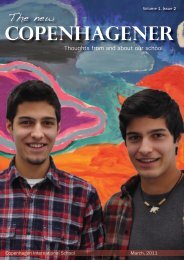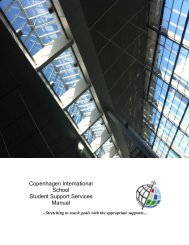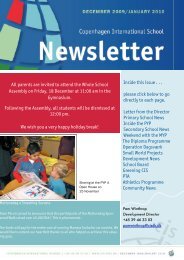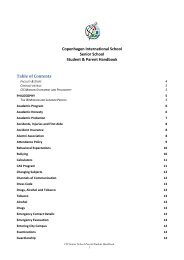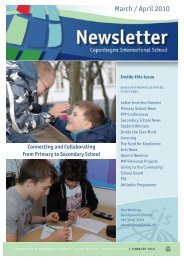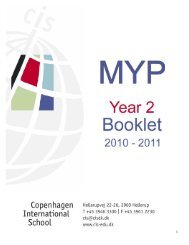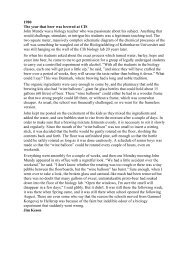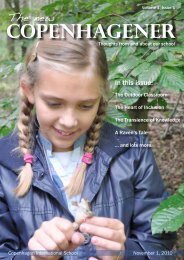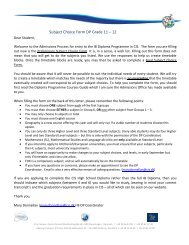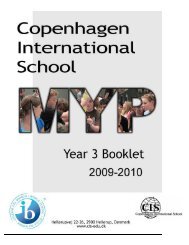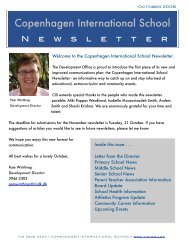German B - Copenhagen International School
German B - Copenhagen International School
German B - Copenhagen International School
You also want an ePaper? Increase the reach of your titles
YUMPU automatically turns print PDFs into web optimized ePapers that Google loves.
Assessment<br />
Criteria<br />
A One World<br />
B Communication<br />
in Science<br />
C Knowledge and<br />
Understanding<br />
of Science<br />
D Scientific<br />
Enquiry<br />
E Processing<br />
Data<br />
F Attitudes in<br />
Science<br />
MYP1 students should be able to:<br />
give examples and make comments on the ways in which science is applied and used to<br />
address specific problems or issues<br />
make comments on the effectiveness of science and its application in solving problems or<br />
issues<br />
make comments on how science and its application interact with life, society and the world.<br />
use scientific language correctly,<br />
with guidance, use appropriate communication modes, such as verbal (oral, written), visual<br />
(graphic, symbolic) and communication formats (laboratory reports, essays, presentations)<br />
with guidance, acknowledge the work of others and the sources of information used by<br />
documenting them using a recognized referencing system.<br />
with guidance, recall scientific knowledge and use scientific understanding to construct s<br />
scientific explanations<br />
apply scientific knowledge and understanding to solve problems in familiar and, with<br />
guidance, in unfamiliar situations.<br />
analyse scientific information by identifying components, relationships and patterns and,<br />
with guidance, make comments on the validity and quality of the information.<br />
with guidance, articulate the problem or research question to be tested by a scientific<br />
investigation<br />
ask questions of the type: “What will happen if”, “Why does this happen when” and make<br />
predictions (“If I do this, then this will happen … ”),<br />
carry out investigations, consistent with the level of complexity of the units of work covered,<br />
and, with guidance, identify the variables that can be measured (dependent variables), the<br />
variables that can be manipulated (independent variables) and those that must remain<br />
constant (control variables); identify the materials and/or equipment needed; describe a<br />
simple method.<br />
with guidance, make comments on the method and the quality of the data collected; ask<br />
questions of the type: “Is the method effective/workable/ feasible”, “Is the data accurate/<br />
reliable”<br />
with guidance, make comments on how the outcome of the investigation helps to answer the<br />
research question; ask questions of the type: “Is my hypothesis/ research question<br />
supported by the data”, “Does the outcome of the investigation support the research<br />
question”<br />
with guidance, suggest improvements to the method<br />
with guidance, collect and record data using units of measurement as and when appropriate<br />
with guidance, organize, transform and present data using simple numerical forms (including<br />
mathematical calculations) and visual forms (tables, graphs and charts)<br />
with guidance, analyse data/information to identify trends, patterns and relationships,<br />
and use the data to convey understanding/ interpretation<br />
with guidance, draw conclusions based on the analysis and interpretation of the data; ask<br />
questions of the type: “What might have caused….”, “How can we explain what happened<br />
using what we know about science…”.<br />
work safely and use material and equipment competently<br />
work responsibly with regard to the living and nonliving environment<br />
work effectively as individuals and as part of a group by collaborating with others.<br />
29


